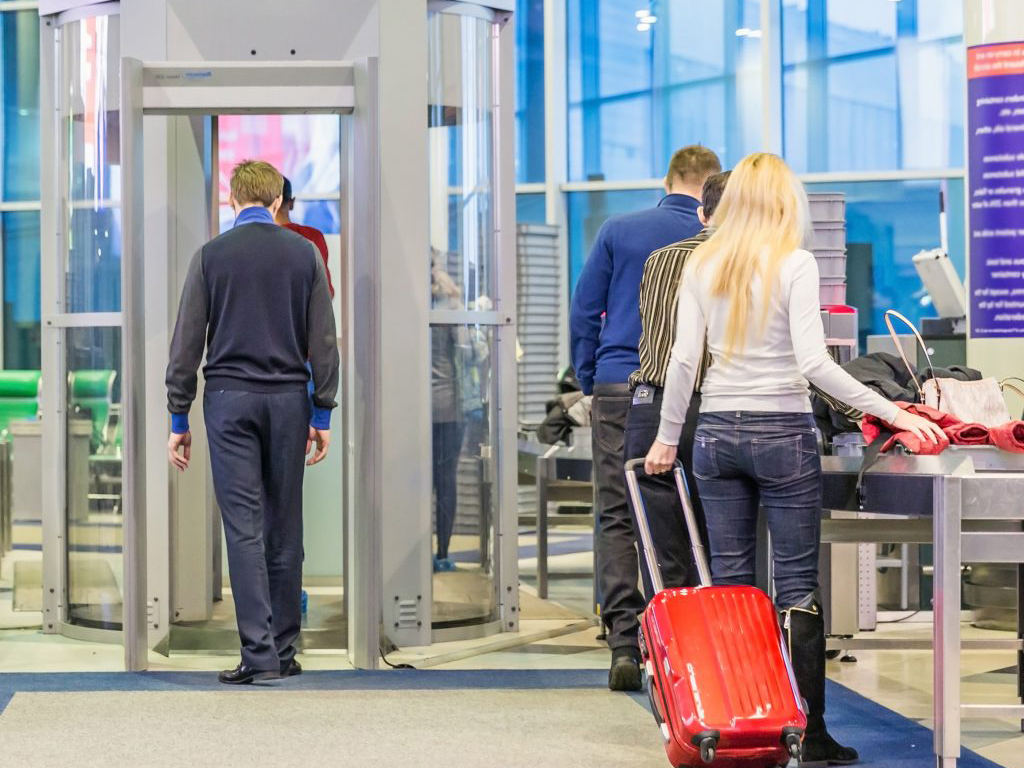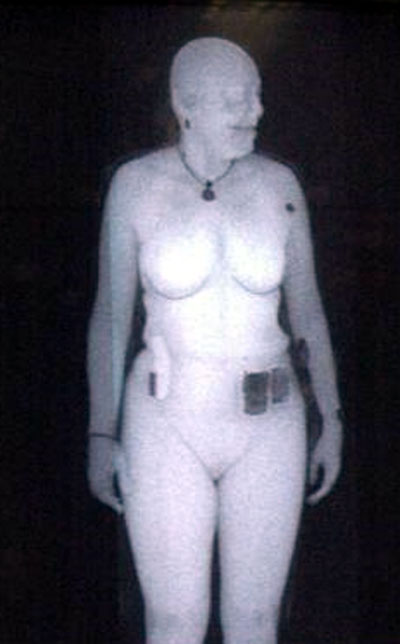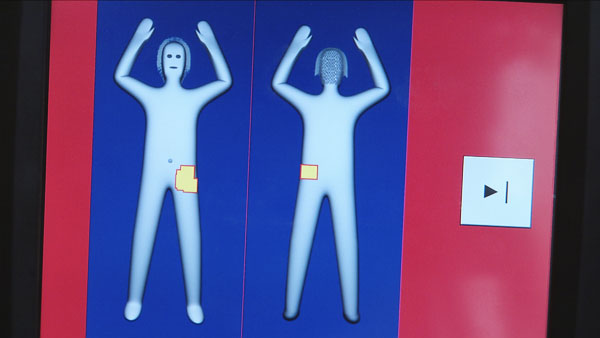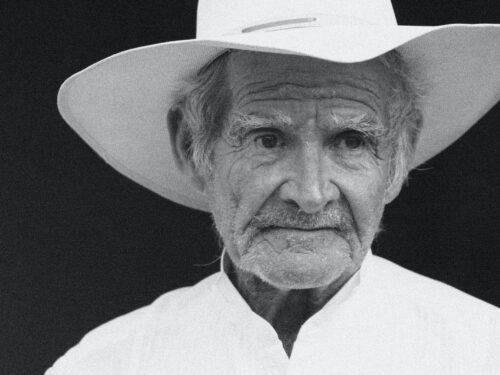Going through airport security is dehumanizing enough as it is. They're going to scan through your luggage and see everything you've packed, you need to empty your pockets and take off your jacket and belt and shoes, and then stand there in a booth like a weirdo with your arms up over your head in the participatory part of 21st-century security theater. And then, inevitably, you're selected for extra screening: a pat down. Is it random? No, the scanner highlighted a suspicious object on your person. In particular, right between your legs.
*sigh* This again? Okay, pat away, officer.

So what is happening here? This is what happens with the backscatter X-ray and millimeter wave scanners used by the TSA. These scanners use low levels of radiation to penetrate through your clothing and reflect back an image of the front and back of your body and any items you may have on your person.
Backscatter X-ray sees everything
The first generation of scanners were the backscatter X-ray variety, rolled out soon after the complete revamp of transportation security after the terrorist attacks of September 11, 2001. These scanners promised to pick up what the metal detectors that had defined airport security checkpoints for years had failed to see: non-metallic objects hidden under the clothing. We're talking ceramic blades, plastic explosives, bags of drugs, and so on.

In addition to putting out a concerning amount of radiation, especially for frequent fliers, the backscatter x-ray machines also came under scrutiny because of the fidelity of images that they produced. You could see everything about the shape of the subject's body and whatever they had on their person. And as the TSA was not and still is not known for hiring the cream of the crop for manning these security checkpoints, those images were the subject of derision and lewdness by TSA agents.
Compounding matters was that in the early days, those scans were seen by the same people that would be deciding who to pat down, so they got to see you naked and the could use that to decide whether you needed to be felt up patted down for additional security. Huge privacy issue there, no? This was temporarily rectified by removing the screens to a different room to be evaluated by agents that could not see you in person, who would then relay to the agents at the checkpoint who required extra screening, but that still didn't get around the fact that you had to submit to having a complete stranger view a 3D scan of your naked body every time you flew.
But at least if those remote screeners saw that what was between your thighs was obviously a huge dick and balls then maybe they would let you through unaccosted — even if they were giggling at the sight.
Millimeter wave brings privacy… and pat downs
That all changed with the introduction of the millimeter wave scanners in 2007 that now populate most airport checkpoints. These new scanners use a lower-energy radiation than X-rays to accomplish the same scan, and also include a bit of software called "Automatic Target Recognition." This software understands what the typical shapes and contours of human bodies of all sexes and sizes are, and uses that to detect unusual shapes on the body.
ATR is pretty decent at picking up the hard edges of items being carried on the body, as well as unusually shaped lumps like bags of cocaine strapped to the stomach with plastic wrap. Unfortunately for well-endowed men, large genitals often also get flagged as unusual shapes compared to the typical human. It doesn't matter whether you're flying commando or stuffed into briefs, a large mass is a large mass.

When sometime unusual is detected, the ATR software displays a virtual mannequin of the subject, highlighting the area to be targeted with additional screening. This at least means that there aren't any TSA agents ogling chalky white images of every body that passes through their scanners, but it does mean that there's no discretion in looking at the scanner and deciding "That's a penis" and letting you through. The computer flags it as unusual and the agent has no choice but to check.
Of course, large dicks aren't the only thing caught up in the millimeter wave scanner's unusual shapes flagging. People flying with prosthetic body parts, colostomy bags, and more routinely get flagged and pulled aside for embarrassing pat downs. So while it may be blush-inducing for a TSA agent to pat up the inside of your thigh with the back of their hand until the make contact with your junk, it's also not the worst thing in the world. Though it is one of the most absurd issues owners of big dicks face.
Skip the big dick pat down with TSA PreCheck
I swear, this isn't an ad for the TSA's expedited screening program TSA PreCheck. But for frequent fliers, it's a great option — especially if your large penis leads to you getting a pat down more often than not.
In addition to allowing you to keep on your shoes and coats, leave large electronics in your carry-on bag, and generally moving faster because the line is full of seasoned travellers, TSA PreCheck also usually runs its screening lines through metal detectors instead of body scanners, and those don't care at all about the size of your ding dong.
TSA PreCheck requires an annual fee of $85, though a number of credit cards and loyalty programs will cover that cost, US military members are also covered by the program, as long as they enter the right information upon booking their flight.
I used to fly a lot for work, and getting patted down on a regular basis by the TSA because my large junk confused a computer was a minor hassle and embarrassment. But since getting onto the PreCheck program, that largely became a thing of the past. There are still random pat downs even for PreCheck travellers, but at least I can rest assured that it's not happening because my dick's too big.











